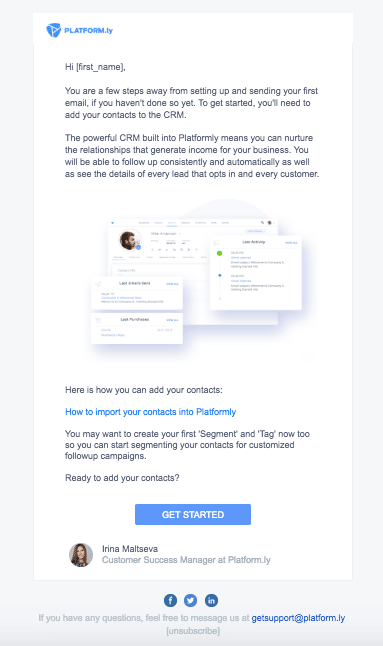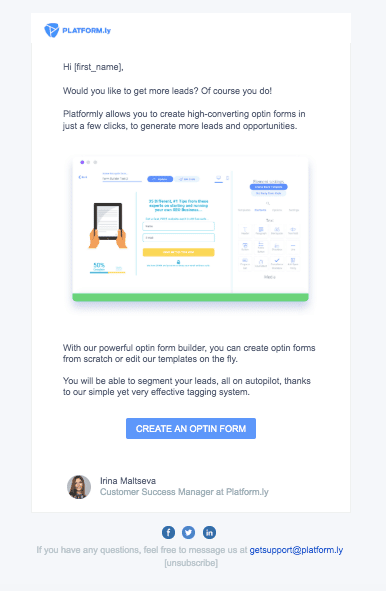You’ve been burning the candle at both ends and a lot of website visitors signed up for your product. You are ecstatic and think that it’s time to celebrate the victory… but you can’t do it now.
When website visitors convert into free trial users, it doesn’t mean that they will become your clients, it’s just the beginning of their journey.
Tech businesses lose 80% of new users within the first ten days after the signup. At the same time, if companies can reduce this churn by even 5%, they can increase profits by 25-125%.
To prevent user churn at this vital stage in your funnel, you must educate customers on the key benefits they can obtain and help them to reach the “aha moment.” Your user onboarding plays a critical role in this process. According to Chief Marketer, sending simple welcome emails to your customers increases engagement by 33%.
Why is Email a Fundamental Onboarding Channel?
If you think that email marketing is dead, statistics show you would be wrong. The survey conducted in 2019 discovered that email marketing has an average return of investment of 4400% and remains the best channel to attract and retain customers.
Moreover, every year the number of promotional and onboarding emails sent to readers continues to increase; however, it doesn’t affect the open rate. It’s still one of the highest among the other marketing channels.
Every time you sign up for a new service or product, you expect something to happen right after you create an account, you are waiting for email notification and further instructions. The first welcome email is usually the one that users engage the most because they expect it.
It May Sound Corny, But You Need a Strategy and Goals
Before setting up your onboarding emails, write down the specific goals you want to achieve and identify constraints that prevent users from reaching the milestones.
The most common reason why user onboarding is essential is that users lose their interest very fast when the product takes too long to understand. It isn’t easy for new users to instinctively know how to utilize your product, mainly if they used the other software with a different interface and features. Creating a positive first-time user experience should be the primary goal of all SaaS businesses owners.
At Platformly, which is an all-in-one marketing automation software with dozens of different features, a simple 5-emails onboarding sequence helped us to increase the initial product retention and keep users motivated until they discover the “aha moment.” Our first simple welcome email got a 250% open rate (yes, people opened it more than once) and 23% CTR (with the average industry benchmark 14.4%).
In this article, I want to share with you the simple tactics that made our onboarding emails convert and helped to retain hundreds of customers.
5 Onboarding Email Tactics You Should Implement Now
1. Send your welcome email immediately
Never delay the sending of your welcome email, you should reward the interest of the users as soon as you can. Welcome emails are the ones with the highest open rate because people are waiting for them, and their attention at that moment is at its peak. Delay it by even a few days – and you will get a much lower engagement.
At Platformly, we set up a trigger – to send an email immediately (in 0 minutes) when contact added to segment “Active Members.” So each time someone joins our product, a welcome email will automatically be sent to them.
2. Give email some personality
Humans want to buy from humans, not from businesses. Make your onboarding emails feel that you have a one-on-one conversation. Write in the first person, CEO, or CMO could give a warm special welcome to the new product users.
In our onboarding emails, Platformly CEO Colin introduces himself. He writes it in a first-person, making customers feel that he is a real human and is happy to help them anytime (which is true). This way, customers feel more connected to the company and know that whenever they have a problem, they can respond to his email.
When you create a similar email, don’t forget to give the email address an avatar and avoid sending messages from a no-reply email address.
3. Don’t focus on features
Educate your users on the topic, not just on your features. Onboarding emails shouldn’t look like product manuals. They should cover the whole user journey.
The end goal of your onboarding sequence is not to teach a user how to navigate your product interface. It’s to introduce “what is in it for me” and show the benefits of your product.
Highlight in the emails what users will ultimately gain from using your product, provide them with some tips and educational materials. They are more interested in how your product will help them to grow business and save money rather than reading a boring endless list of your features.

4. Use behavior-triggered emails
Behavior-triggered email marketing centers around delivering the right message to the right person at the right time. It helps to focus your business efforts on what matters the most – retaining your customers.
Triggered emails are delivered to your customers’ inboxes as a result of their behavior on your website, inside of the product, with your emails, etc.
Here are a few use cases on how you can benefit from behavior-triggered emails:
- Support your customers on their journey: congratulate them for completing specific actions inside of your app, walk them through the next steps to do, etc.
- Respond to inactivity: you can win back customers’ attention by sending re-engagement emails when a user doesn’t login to your app for a specific time or didn’t have an opportunity to try some features.
- Reward the positive behavior: once you identify some positive behavior (NPS above 7, customer invites friends to try the app, etc) you can trigger the emails that can help you reward these highly-engaged customers.
At Platformly, we send behavior-triggered emails to those customers who didn’t have an opportunity to try some of the vital product features within a free trial period.

5. Receive feedback and provide your help before users go
Ask your customers if they need any help or assistance a couple of days before the end of a trial. It’s an excellent opportunity to win-back some users before they leave forever and get insights on how to improve your product.

We send this email automatically to all users after the ten days since they sign up. We already received dozens of messages with feedback on how the product could be improved and what challenges users face during the free trial period.
We learned that many people were struggling because they weren’t able to find a specific feature they needed or needed more training materials to set up their accounts entirely. After receiving this feedback, we implemented better customer training, added more “how-to” articles to our helpdesk, and improved the UI of some features.
Can you imagine how valuable feedback like this could be for your business? It’s truly priceless.
Wrap up
Once you setup your onboarding emails sequence, don’t forget to track the performance. There are three most important metrics to measure: open rate (which is 57% for welcome emails), click-through-rate (which is 14% for triggered onboarding emails), and conversion rate (which could be around 4% for welcome sequences).
Feel free to steal and customize all of our emails for your onboarding campaigns. Don’t forget about one thing – your onboarding process is the thing that you should always be trying to improve.


